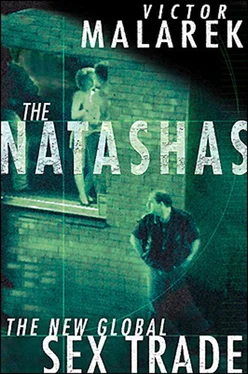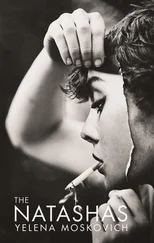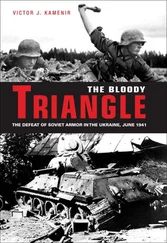My next stop was the nearby Bohemian hamlet of Dubi. Once famous for its blue-and-white, onion-shaped porcelain known as “cibulak,” it is now infamous for loose women. Dubi is anything but charming. Bars with names like Alibi, Libido and Kiss line the main street alongside a string of fleabag hotels and pensions where no one stays the night. Since the opening of Germany’s borders in 1989 the number of prostitutes working on the Czech side of the border has mushroomed. There are a score of bars and each has a dozen or more young women sitting at tables or dancing to disco music as they wait for the next man to arrive. Over a glass of cheap wine negotiations are quickly finalized, followed by giggles and a little groping before the twosome head off to a room above or at the back of the bar.
“This region is a sex zoo,” a police officer said acidly. “Nobody in government is interested in stopping it. So why should I bother? My job is to make certain there is no trouble, and these whores know better than to make trouble.”
I asked if he thought many of the women were trafficked and forced to work as prostitutes.
The officer laughed. “They have a choice to be prostitutes or to live the good life. They have chosen to be whores.”
A little farther down the roadway in the picturesque hills of the Bohemian Highlands is the spa resort town of Teplice. It harbors a dark secret—the tragic consequences of the sordid romps on E-55 and in Dubi. Every year, dozens of unwanted babies are born and abandoned at the local hospital. They’re the result of clients willing to pay a little more for sex without a condom, and of women who aren’t given any money from their pimps to purchase alternative birth control. On average, three prostitutes give birth each month. Many of the babies are born with syphilis or are HIV-positive. Some are drug addicted. A doctor at the hospital noted that abortions are costly and that many of the women work right up to the day they go into labor. In fact, a steady stream of clients comes specifically to have sex with pregnant women, and they’re willing to pay a premium for the opportunity.
Nearby in a beleaguered orphanage, about seventy E-55 babies are on display, awaiting adoption.
I knew I did not have the strength to endure what would surely follow if I resisted.
—SOPHIA, WHO WAS “TRAINED” AFTER HER THIRD DAY IN CAPTIVITY
OLEKSANDER MAZUR KNOWS all about the breaking grounds. A Ukrainian police officer, he was assigned to the United Nations international police force—CIVPOL—in Pristina, the capital of Kosovo. His job was to kick down the doors of brothels and rescue trafficked women in this renegade Serbian province. For a little more than a year he did just that, and in that time he rescued more than a hundred women—most of them mere teenagers.
“I would like to clean up this mess for good,” Mazur said. “I would like not to have this job. It has cost me my dreams.”
From numerous investigations, Mazur has compiled an impressive dossier on the traffickers and their operations. He knows the enemy well—what it looks like, how it thinks, how it moves. He knows the names of several key players; their descriptions are etched in his mind. More important, he’s figured out the locations of secret training centers in Serbia where these thugs snap the spirit and will of their terrified hostages. These centers lie within his grasp, but he is absolutely powerless. His mandate is limited to Kosovo. The breaking grounds, just a few kilometers across the border in Serbia, are in neither his job description nor his jurisdiction.
I would love to have the power, the authority to go into Serbia and catch the criminals and shut them down for good. Here it’s like getting the street-level drug dealer. It’s frustrating, especially when you know you can get the main traffickers but you are not allowed to cross the border. I’ve got a lot of information. It is not such a big deal to catch them. You just go there and break down the gate.
Belgrade is the main center in Serbia. There are also apartments in Nis and Kraljevo. There are places there that are like prisons, where hundreds of young women are held until they’re sold. It is there the girls are broken. It is where they are trained. Those places are hell.
Anna Eva Radicetti has also heard about the Serbian breaking grounds through her interviews with scores of rescued women. As manager of the Counter-Trafficking Return and Reintegration project of the International Organization for
Migration in Kosovo, she too has gathered reams of information about what happens to trafficked women on the other side of the border. “There are big apartments or houses in Belgrade where most girls are brought. Sometimes there are fifty girls in each place,” she explained. Radicetti has learned that potential buyers “test-drive” the women, much like the way we test-drive new cars. “They are sex-tested by each buyer. They want to see for themselves what the girls can do in terms of sex performance.”
When they’re not being used, she said, the young hostages are poked and prodded like cattle.
They have to stand naked for hours a day while men come and look them over. They look at their breasts, the color of their skin and check to see if they have rashes or pimples. The girls have to dress up to look like prostitutes and put on makeup. Those who resist are isolated, beaten and terrorized. It’s even more humiliating for them if they are considered ugly. They are treated worse than animals with what they are forced to do. You have a full range of traffickers, from cruel to vicious.
What happens to most trafficked women, whether they were tricked, abducted or willing, is criminal. They are forced into situations of profound terror, comparable to being held hostage. They are immediately deprived of their travel documents and their every movement is tightly controlled and restricted. Usually they live on the premises, where they work, locked in rooms, under constant guard and in fear of extreme violence and threats. They are warned that if they try to escape, they will be found and severely punished. They are also told that their families will be targeted. Often they’re videotaped or photographed in embarrassing sexual encounters, and warned that if they escape, the pictures will be sent to their families and distributed around their hometowns.
SOPHIA RECOILED WITH SHEER PANIC when asked about her abduction at knifepoint while walking home one evening on a rural road about a kilometer from her home.
“I could hear the car approaching and suddenly I froze. I could not move,” the eighteen-year-old Romanian said, nervously spinning her shoulder-length black hair in her fingers as she recounted the nightmare that became her life for the next four months.
Two men with knives forced me into the car. I thought they would rape me and then kill me. I prayed that my life would be spared. Instead, I was driven to a river crossing where they sold me to a Serbian man. He took me across the Danube River in a small boat and then to an apartment in a town in the mountains. I don’t know the name. But I soon learned I was in Serbia.
Sophia was horrified by what she witnessed during her brief imprisonment in the building. Her experiences continue to haunt her in her sleep, and are typical of what women encounter in the breaking grounds.
There were so many young girls in there. They were from Moldova, Romania, Ukraine and Bulgaria. Some were crying. Others looked terrified. We were told not to speak to each other. Not to tell each other our names or where we were from. All the time, very mean and ugly men came in and dragged girls into rooms. Sometimes they would rape girls in front of us. They yelled at them, ordering them to move certain ways… to pretend excitement… to moan… It was sickening.
Читать дальше












